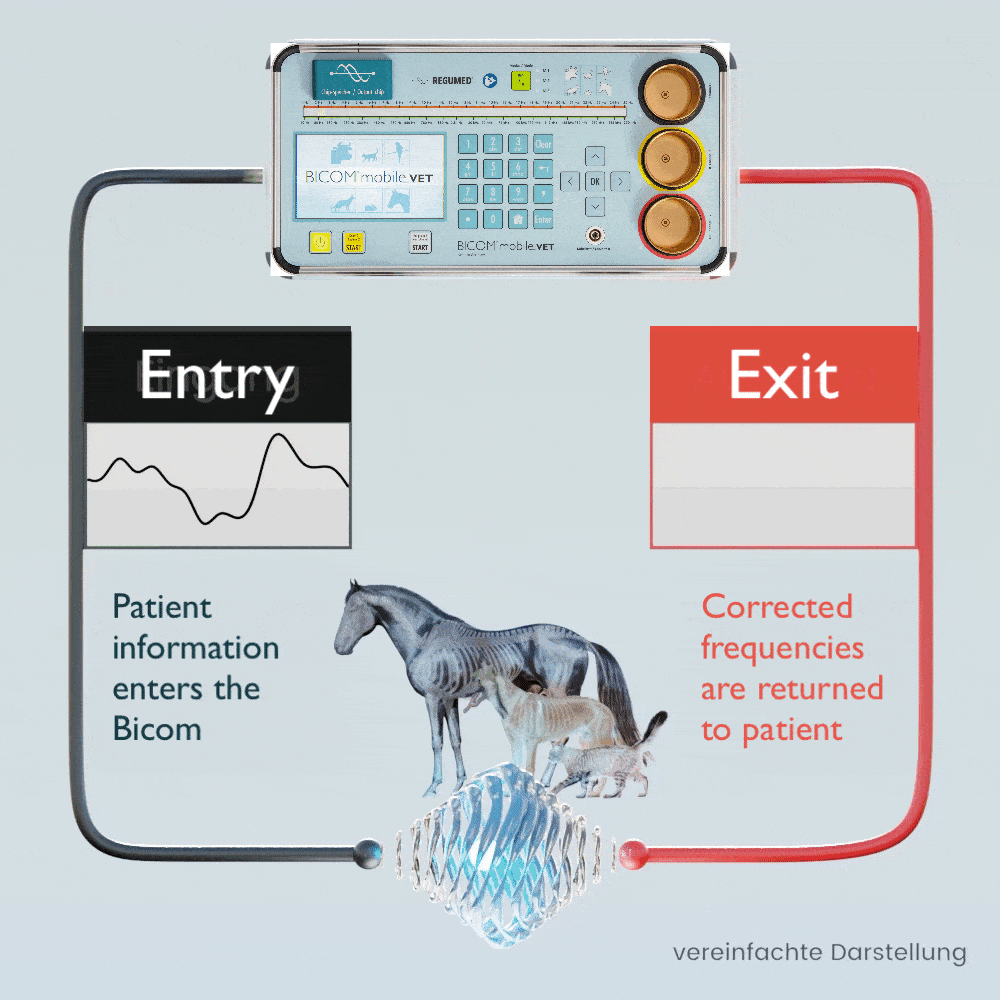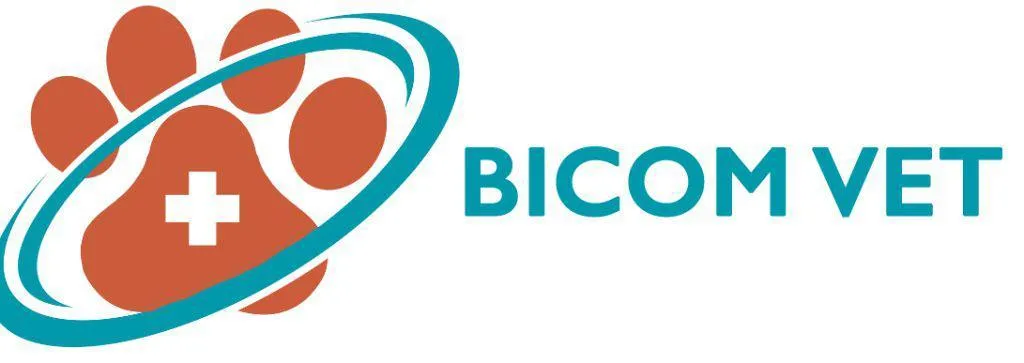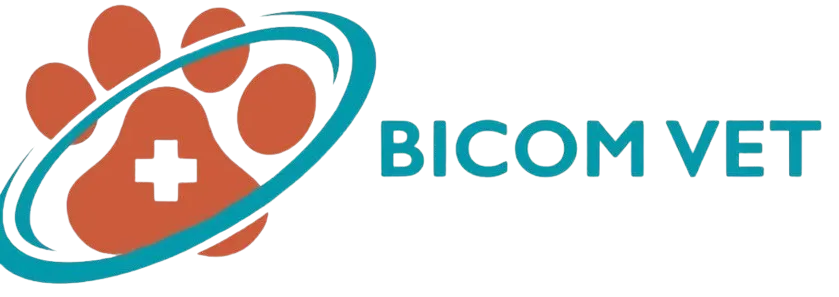Treatment with the help of the patient’s own information
in the BICOM® mobile VET bioresonance device
In contrast to other “frequency therapy devices”, BICOM® bioresonance is a method that is highly individual and perfectly tailored to the needs of the patient through the use of the patient’s own information and the possibility of testing specific wave patterns for resonance.
The patient’s own pathological and physiological information is recorded using special applicators and fed into the BICOM® mobile VET.
Depending on the therapy program, the specific wave pattern as a carrier of information is amplified, weakened or inverted and transmitted back to the patient in modulated form, which means that the transmission of information changes in clarity depending on the modulation or it disappears completely.
The treatment signals continuously adapt to the changing pathological situation of the patient. As the therapy progresses, the body’s ability to regulate is reactivated.
Find out more about this topic at our regular events. Together with veterinarians and animal naturopaths, we offer various face-to-face and online events .
The BICOM® bioresonance method is a cause-oriented, holistic treatment concept. It can narrow down the cause of the health problem in animals and find out even the hidden causes of the clinical picture.
Animals have a natural regulatory system that can also compensate for unusual influences. However, even good self-healing powers eventually reach their limits. Persistent exposure to allergens, environmental toxins, fungi, viruses, bacteria or stress and changed living conditions weaken the immune system and are often the cause of an illness. In particular, fungal infestation on the skin or chronic diseases in general are not always due to a breeding-related genetic defect, but are signs of a disturbed immune system.
The BICOM® bioresonance method is the key to successful diagnosis and therapy, especially for animals that cannot tell us exactly where it hurts or what the symptoms are. It is a gentle form of therapy that can be carried out without side effects and without additional stress for the animal.
The BICOM® mobile VET records the bioenergetic state of the animal, processes the information it contains and returns modified vibrations / therapy frequency patterns to the animal. Symptoms and stress can be diagnosed and targeted therapy can be initiated.
Through the use of endogenous and exogenous substances, the body’s own self-healing powers can be activated and imbalances that have existed for a long time can also be regulated.
REGUMED Medizintechnik are pioneers of the BICOM® bioresonance method. More than 30,000 therapists worldwide, well over 10,000 of them in Germany, successfully use their therapy concept.

Biophysical basics of the bioresonance method
Life is only possible when three conditions are met: matter, energy and information.
We also find these aspects in conventional medicine, both in diagnostics and in therapy. For example, every drug is also a carrier of information.
Information is neither energy nor matter, it is immaterial and comparable to the meaning of a message from a sending to a receiving system.
In addition to the electrical processes in the receptor proteins and biomembranes in general, electromagnetic interactions through light (biophotons) also play a role in cell communication and the transmission of information.
Specific electromagnetic wave patterns act as information carriers. These wave patterns can be modulated by the BICOM® device in order to eliminate disturbing or stressful information in an organism.
The goal is to restore the free flow of healing information (cell communication) and thus support the self-regulation of the organism and the self-healing powers.
Individual, patient-specific information or information from native substances, digitized substances or information stored on storage media can be used for therapy.
What your colleagues are saying…

Is Bioresonance Safe for Pets? Risks & Facts for Vets
Is Bioresonance Safe for Pets? What Veterinarians Should Know
Bioresonance therapy, an alternative treatment claiming to diagnose and treat ailments by using electromagnetic waves, has gained popularity in both human and animal healthcare. It has been marketed as a non-invasive, drug-free solution for various conditions in pets. However, the safety and effectiveness of bioresonance therapy, particularly for pets, remain contentious topics among veterinarians. In this blog, we’ll explore the dangers of bioresonance and what veterinarians should know to make informed decisions about its use in pets. Understanding the risks involved in bio resonant therapy is crucial for professionals responsible for animal welfare.
What is Bioresonance Therapy?
Bioresonance therapy operates on the principle that every organism, including animals, emits its own electromagnetic frequencies. Practitioners claim that diseases or imbalances in pets result from distorted frequencies within their bodies. Bioresonance devices are said to detect these frequencies and adjust them to promote healing. However, this theory lacks substantial scientific backing, and the mechanisms behind how bioresonant therapy could work remain unclear.
The therapy involves placing electrodes on the pet’s skin, which are connected to a machine that reads the pet’s frequencies. The device then supposedly corrects any imbalances by emitting counter-frequencies. While this may sound appealing as a non-invasive and holistic treatment, it’s essential to evaluate the potential dangers of bioresonance before recommending or using it on pets.
The Dangers of Bioresonance for Pets
Lack of Scientific Evidence
The most significant danger of bioresonance therapy is the absence of scientific evidence supporting its effectiveness. No robust studies demonstrate that bioresonant devices can accurately diagnose or treat any condition in pets. Without proper research, it is difficult to ascertain whether bioresonance is genuinely beneficial or merely a placebo. Using unproven treatments on animals can delay more effective, evidence-based interventions, posing a serious risk to their health.Misdiagnosis and Missed Treatment
Bioresonance therapy often promises to diagnose a wide range of illnesses, from allergies to chronic diseases. However, since the devices are not scientifically validated, there’s a real risk of misdiagnosis. For example, a pet with a treatable condition might receive a wrong diagnosis, leading the owner to focus on bioresonance therapy rather than seeking proven medical treatments. This delay in proper care can worsen the animal’s condition and, in severe cases, lead to life-threatening consequences.False Sense of Security
Pet owners who believe in the benefits of bioresonance may develop a false sense of security, thinking that their pets are being effectively treated. This belief can lead to negligence in following up with conventional veterinary treatments. In reality, bioresonance therapy is not a substitute for professional veterinary care, and relying solely on it could compromise the pet’s well-being. Veterinarians should inform pet owners about the dangers of bioresonance, emphasizing the importance of conventional treatments for diagnosed conditions.Unregulated Devices
Another danger of bioresonance therapy is the lack of regulation surrounding the devices used. Unlike medications or veterinary equipment, bioresonant devices do not undergo rigorous testing to ensure they are safe or effective. There is no standardized protocol for their operation, and anyone can manufacture and sell these devices without meeting strict safety criteria. This lack of regulation raises concerns about the quality and safety of the therapy administered to pets.Potential Stress and Discomfort for Pets
Although bioresonance therapy is promoted as non-invasive, the experience may still be uncomfortable for some pets. Having electrodes attached to their bodies, along with the unfamiliar sensation of the device in operation, can cause stress, especially in anxious animals. Pets often communicate discomfort through subtle behaviors, and the additional stress of such therapy might aggravate their condition. Veterinarians should weigh the potential stress that bioresonance can cause against any unproven benefits when deciding whether to recommend it.Untrained Practitioners
Bioresonance therapy can be administered by individuals with varying levels of training, from veterinarians to non-veterinary practitioners. This inconsistency poses a danger, as unqualified practitioners may not have the expertise to properly diagnose or treat animals. Without the necessary knowledge of animal physiology and veterinary medicine, there is an increased risk of misdiagnosis or inappropriate treatment, which can further endanger the pet’s health. Veterinarians should caution pet owners about the risks of seeking bioresonance therapy from unlicensed or underqualified practitioners.Lack of Individualized Care
Each pet is unique, and their healthcare should be customized to their specific needs. However, bioresonant therapy often follows a one-size-fits-all approach, with limited customization based on the individual animal’s condition. This lack of personalized care can be dangerous, especially for pets with complex or chronic health issues. By contrast, veterinarians provide individualized treatment plans based on a thorough understanding of the animal’s medical history, current condition, and specific needs.
What Veterinarians Should Consider
Given the potential dangers of bioresonance therapy, veterinarians must approach this treatment with caution. Here are key factors to consider when evaluating its use:
Evidence-Based Practice
Veterinarians are guided by evidence-based medicine, which involves using treatments that are supported by scientific research. Since bioresonance lacks reliable evidence, veterinarians should remain skeptical of its effectiveness and prioritize proven medical interventions. Educating pet owners about the dangers of bioresonance can help prevent them from turning to unproven therapies and ensure that pets receive the care they need.Client Communication
It’s essential for veterinarians to have open, honest conversations with pet owners about bioresonance therapy. Many owners may be drawn to alternative treatments out of concern for their pets’ well-being, hoping for a solution that avoids drugs or surgery. Veterinarians should explain the risks, including the lack of scientific validation and the potential dangers of bioresonance, while highlighting the importance of conventional veterinary care.Balancing Holistic and Conventional Approaches
Some veterinarians may be interested in offering holistic therapies alongside conventional treatments. While integrative medicine can provide benefits in certain cases, it is important to ensure that any alternative therapies, such as bioresonance, are backed by research and do not pose risks to the pet. Veterinarians should carefully assess the safety and efficacy of all treatments and avoid using bioresonant therapies until there is stronger evidence to support their use.Ethical Responsibility
Veterinarians have an ethical responsibility to protect the health and well-being of their patients. This means avoiding treatments that have not been proven safe or effective. Offering or endorsing bioresonance therapy without clear evidence could compromise a veterinarian’s ethical obligations, especially if it leads to harm or delayed treatment for the animal. Veterinarians must prioritize the pet’s welfare above all else and remain cautious about using unproven therapies like bioresonance.
Conclusion
In conclusion, bioresonance therapy presents several dangers for pets, including the lack of scientific evidence, misdiagnosis, and potential harm from unregulated devices. While it is marketed as a safe and holistic treatment, veterinarians should be aware of the risks and exercise caution before recommending it to pet owners. Educating clients about the dangers of bioresonance and encouraging evidence-based veterinary care will help ensure the health and safety of their pets.
Veterinarians should remain informed and prioritize treatments that are proven to be safe and effective. Until more research supports the use of bioresonance in veterinary medicine, it is advisable to steer clear of bioresonant therapies and focus on established, evidence-based practices.
Treatment Priorities
For gentle and optimal treatment of the causes of diseases in animals
The BICOM® bioresonance method is predestined for use with large and farm animals such as horses , but also with dogs , cats and small animals. The treatment focus of the BICOM® mobile VET is wide-ranging. It is now used for many indications.
It recognises health deficits at an early stage and is used, among other things, for the following symptoms:
sweet itch
Feed intolerances
allergies and related diseases
COB/COPD
leishmaniasis
Lyme disease
anaplasmosis
lameness in horses
hoof ulcer
Poisoning by poisoned baits, plants etc.
mauke
Feline infectious peritonitis (FIP)
Cat flu/cat disease
eye/conjunctivitis
and much more
Get advice now!
Our experts are happy to be there for you personally
Our BICOM® bioresonance experts are available to answer any questions you may have
and will be happy to advise you personally and individually.




Request more information
Quick Links





Facebook
Instagram
Mail